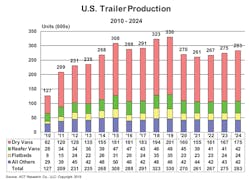The transportation equipment market has presented “an interesting dichotomy” in 2019, with booming sales and production numbers but, when truck and trailer OEMs opened the 2020 order books … crickets. That’s according to presentations by economists, market analysts, equipment manufacturers and other industry insiders at ACT Research’s annual summer gathering. Seminar #61 was held August 12-14.
Frank Maly, ACT’s director of CV Transportation Analysis and Research, noted the “dramatic spread” between the ongoing record market build and the collapsing demand.
“Earlier this year, there were fleets that were scrambling for more production slots. And on the trailer side, the OEMs weren’t willing take the orders,” Maly said. “Now that the order board has opened up, no one’s really come to the party. It’s not dramatically different from what we’re seeing now in Class 8 [trucks], but it’s certainly something we haven’t seen in this segment of the business for a while.
“Fleets are kind of reticent. They’re sitting back, trying to decide what they really need.”
Additionally, inventories have climbed while order cancellations have begun to surge, he noted. So, not surprisingly, June’s trailer orders were the lowest since September 2009, at the low point of the Great Recession.
“We’ve heard comments about [OEM] discussions with fleets, but no [order] commitments,” he said.
On the other hand, trailer manufacturers have posted six of the top production months in history over the past 12 months, with build slots filled through December since the second quarter this year.
“We just can’t get over the hump, into 2020,” Maly said. “2020 is not going to be a bad year, but it’s certainly not going to be the kind of year we’ve seen over the last two or three.”
Outlook
In setting the ACT trailer market projection, Maly noted several “troubling” factors for the industry moving forward:
Cancellations: Cancelled orders were more than 6,000 in both June and July. And, as the production guarantee window begins to bump against year end, Maly expressed concern that fourth-quarter trailer output might slip below current projections. He compared the current cancel trend to the similar market conditions of 2016.
“One thing to keep in mind is that as we see fleet consolidation, we tend to see larger orders—and larger orders are driving potentially larger cancellations,” he said. “When the orders can come in big bunches, they can go away in big bunches.”
Inventories: With the factory inventory count for trailers topping 30,000, Maly suggested that ACT would have to re-scale its tracking chart. Inventory is also reported to be growing on dealer lots.
“The whole system is kind of overloaded,” he said. “Are these slow deliveries and pick ups, or is there more going on? I think there may be something more going on, and maybe they don’t all have homes.”
Carrier profits: Two years of record trailer orders and production have meant surging truckload capacity that now has outpaced demand—so shipping rates have fallen and fleets are not making the kind of money they’ve made since the 2018 capacity surge.
“So from a timing issue, this is really lousy because they’re all starting to get into their 2020 order cycles and planning cycles,” Maly said. “Uncertainty just breeds delay. And that’s where we’re sitting right now. That kind of sets us up for potential build-rate adjustments as we move through the rest of the year. And that kind of set us up for a weak foundation to start 2020.”
Indeed, the numbers from here on out will seem all the more “sobering” when compared to the year-over-year numbers.
“The headline percentages are going to get people’s attention,” Maly said.
More broadly, Maly explained that the market is likely returning to a “normal” schedule for fleet orders, after months of record-level backlogs.
“It would be nice if we get to normal order season timing, but we’re still not hearing a lot of interest from fleets as far as the orders that they’re willing to post,” he said.
And that means ACT projects a slowing of the trailer build rate through the end of the year.
“When the backlog starts to shrink, build rates come down,” Maly said. “Maybe [the OEMs] take some days out of the schedule, or maybe if it really gets bad they’ll take a shift out. But that means people and nobody wants to do that. That’s usually a last resort.
“But you end up with a situation where maybe holidays get stretched for an extra day around Christmas, an extra day around Thanksgiving in the fourth quarter.”
Longer term
The trailer boom means the working population is both very large and very young, according to Maly. While the trend holds for dry van, refrigerated trailers and flatbeds, the dry van segment in particularly has seen the population age come down significantly from a period of record highs following the 2008 recession.
And with 2019’s projected production run of 330,000 trailers (up from 2018’s record 223,000) the trends will continue.
The challenge for the industry in 2020, Maly explained, will be to understand that the projected decline is a cooling of the hottest market in history, not a collapse.
“It’s all perspective for 2020,” he said. “Let’s think about this: It’s still going to be in the top 10 in industry volume in history.”
Maly did caution that a slow start to the year will likely cause some concern but, again, manufacturers and their suppliers should appreciate that the market will still be strong.
“That 270,000 trailers [in ACT’s 2020 forecast] would have been considered a phenomenal year anytime before 2014,” he said. “We have additional OEM capacity in the pipeline, so all of a sudden we have what looks like a reasonable year—certainly not a wrist-slashing year by any stretch of the imagination.
“But with that capacity we’ve got OEMs searching for customers, so it could get to be a very interesting competitive landscape.”
ACT forecasts a slip to 261,000 trailers in 2021 before the market grows steadily to 283,000 by 2024.
A wildcard in the trailer forecast is the implementation of greenhouse gas emissions rules for trailers, with federal regulations in legal limbo, but with a California Air Resources Board plan set to take effect in January. The CARB trailer certification plan, however, remains a work in progress even as the deadline looms.
“The whole process is pretty intensive, and we could get some interesting results from the law of unintended consequences,” Maly said. “Regulations make people creative.
“The first quarter could be kind of interesting for trailer dealers in the state of California. But if I sell trailers in Las Vegas, or Reno, or Phoenix, or Tucson, I might have some very good sales because things may not be in place in California or moving as smoothly as they should.”
About the Author
Kevin Jones
Editor
Kevin has served as editor-in-chief of Trailer/Body Builders magazine since 2017—just the third editor in the magazine’s 60 years. He is also editorial director for Endeavor Business Media’s Commercial Vehicle group, which includes FleetOwner, Bulk Transporter, Refrigerated Transporter, American Trucker, and Fleet Maintenance magazines and websites.
Working from Beaufort, S.C., Kevin has covered trucking and manufacturing for nearly 20 years. His writing and commentary about the trucking industry and, previously, business and government, has been recognized with numerous state, regional, and national journalism awards.


